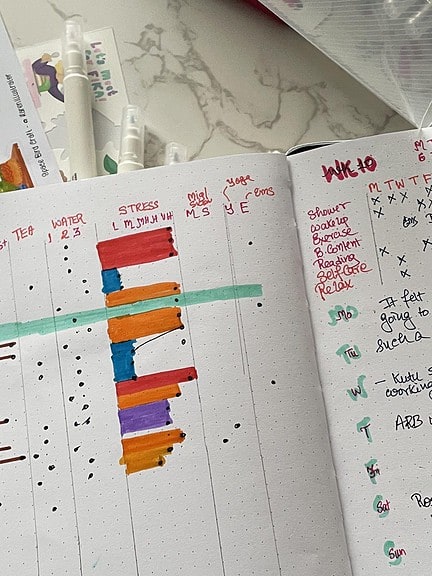By Essi Karimi
About the Author:
Essy Karimi is an adventurous wordsmith who has a passion for reading, hiking, and writing (although she occasionally indulges in a friendly tango with procrastination)
In today’s fast-paced work environment, getting overwhelmed with tasks, distractions, and stress is easy. However, having mental clarity and focus is essential for productivity and success.
Mental clarity means having a clear and focused state of mind, free from indecision, what-ifs, overwhelm, or worry. This article discusses the importance of focus and clarity in the workplace and how mindfulness can help improve overall productivity. We will also provide mindfulness exercises suitable for work environments and the right time to practice them.
Table of Contents
The Importance of Focus and Clarity in the Workplace
Having mental clarity and focus is crucial for productivity and success in the workplace. With clarity around your goals and priorities, moving towards what you want from life is easier. Clarity helps you:
- Find focus and direction, making it easier to get things done.
- Foster a mindset of self-compassion and non-judgment, allowing yourself to be truly seen, regardless of external judgment.
- Stay calm and composed in stressful situations, allowing you to make better decisions and avoid mistakes.
- Improve your creativity and problem-solving skills, as you can approach challenges with a clear and open mind.

How to Use Mindfulness to Improve Productivity
Mindfulness is being present and fully engaged in the current moment without judgment or distraction. It can help you stay focused, reduce stress, and improve your well-being. Here are some mindfulness exercises suitable for work environments and the right time to practice them:
- Focused Attention & Concentration: Take a few minutes to focus on your breath and clear your mind. You can do this exercise anytime during the workday, especially when distracted or overwhelmed.
- Mindful Breathing at Your Desk: Take a few deep breaths and focus on the sensation of the air moving in and out of your body. You can do this at your desk or in a quiet space whenever you need a quick break.
- Mindful Appreciation: Take a moment to appreciate something in your environment, such as the beauty of nature or the kindness of a colleague. The exercise is best suitable when you feel stressed or anxious.
- Mindful Immersion: Fully immerse yourself in a task or activity without distractions or interruptions, especially when you need to complete a task that requires your full attention.
- Mindful Listening: Practice active listening by focusing on what others say without interrupting or judging during meetings or conversations with colleagues.
- Take Breaks: Take short breaks throughout the day to stretch, walk around, or simply relax whenever you feel tired or overwhelmed.
- Learning to Belly Breathe: Take a few deep breaths, focusing on your belly rising and falling with each inhale and exhale at any time during the workday, especially when you feel anxious or stressed
- Mindful Eating While at Work: Take a few minutes to eat your lunch or snack mindfully, focusing on the taste, texture, and smell of the food during lunch breaks or snack times
- Mindful Focus: Focus on the task and recognise and release internal and external distractions as they arise when you need to complete a task that requires your full attention.
Stationery and Journaling
Using stationery and journaling can be a helpful way to combat stress and increase focus and clarity in the workplace. Bullet journaling is a popular method to plan and stay organised. A good example is the Alastair Method, a specific bullet journaling method you can use to plan for the next six months.
Keeping a stress relief journal can be a helpful way to manage stress and improve mental health. Writing down your thoughts and feelings can help you organise your thoughts, clear your mind, facilitate problem-solving, and gain perspective. Some great journaling techniques you can try include:
Bullet Journaling
This system promotes mindful, intentional living and enables you to discover what’s worth your time and energy, helping you clear your goals and priorities. Using bullet journaling lets you put things into perspective and focus on the task at hand.

Work Journaling
Keeping a work journal provides valuable data on how you spend your time, feedback, etc., so you can improve your work performance. It lets you reflect often and then tweak your processes, communication, and time management skills.
Stress Relief Journaling
In ancient and modern times, writing in a diary or engaging in journaling has been revered for its capacity to help individuals outwardly express their thoughts and emotions, leading to a notable decrease in stress and anxiety. It’s one of the most effective tools for stress relief when individuals write in detail about their thoughts and feelings related to stressful events, similar to how they would talk about them in a counselling session.
Remember, journaling and stationery are personal, and what works for one person may not work for another. Experiment with different techniques and stationery items to find what works best for you.
Final Thoughts
Combining mindfulness and stationery tools can create a more mindful work practice. Bullet journaling, for example, promotes mindful, intentional living and can help achieve mental clarity. A daily planner, notebook, or notepad can help keep track of tasks and goals while providing a tactile and portable way to stay organised.
To get the best out of clarity and mindfulness in your workplace, be sure to:
- Take breaks throughout the day to practice mindfulness and reduce stress
- Use high-quality pens and stationery tools that are long-lasting and write without leaking, like those from Dance of Chaos.
- Keep your workspace clean and tidy with desk organisers and wire organisers.
- Use a daily planner or bullet journal to identify goals and priorities
- Practice daily journaling to find more focus and clarity in your life
Now that you understand how to integrate mindfulness, stationery, and bullet journaling into the workplace, it’s time to try it. When you do so, be ready to enjoy enhanced focus, better clarity, and a greater sense of work-life harmony. Additionally, you’ll feel empowered navigating work challenges with calmness, creativity, and purpose, ultimately leading to increased productivity and overall well-being.
About the Author:
Essy Karimi is an adventurous wordsmith who has a passion for reading, hiking, and writing (although she occasionally indulges in a friendly tango with procrastination)

